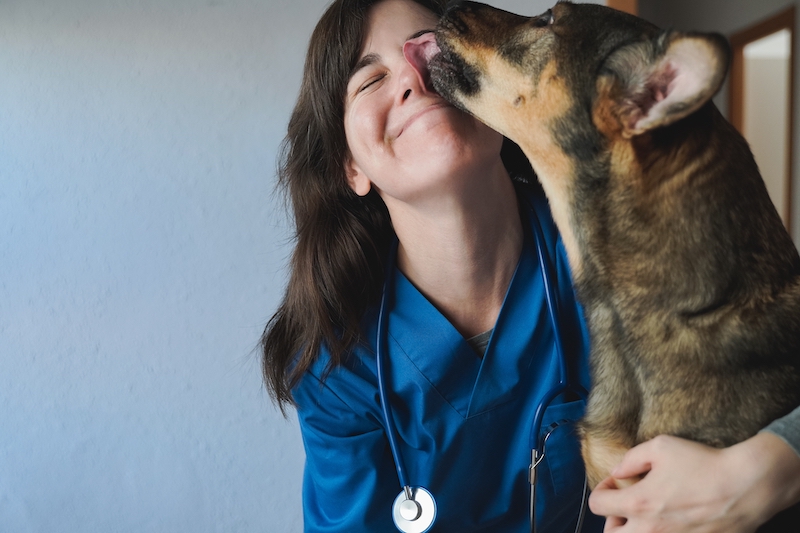- What is a hernia?
- How do dogs get hernias?
- What are some of the signs that my dog might have a hernia?
- How much does hernia surgery for dogs cost?
- What’s included in the cost of dog hernia surgery?
- Does pet insurance cover the costs of hernia surgery for dogs?
- How can I help my pooch fully recover from their hernia surgery?
- Are there alternative treatments for a dog with a hernia?
Surgery is often the best treatment for dog’s with a hernia, but in 2025, dog hernia surgery costs can range from about $150 to $10,000, with an average cost of roughly $1,600.
A dog hernia, if left untreated, can cause discomfort, pain, and potentially life-threatening complications, significantly impacting a dog’s quality of life and overall well-being.
Hopefully your dog will never develop a hernia, but it’s important to be familiar with the signs and treatment options so you can be mentally (and financially) prepared, just in case.
What is a hernia?
A hernia is a condition where an internal part of the body—like an organ or tissue—pushes through a hole or weak spot in the muscle or tissue wall that usually keeps it in place. Oof.
This can occur in various parts of the body in both humans and dogs. In canines specifically, common hernia types include:
- Umbilical: Occurs when part of the intestines or fatty tissue pokes through a weak spot near the belly button (umbilicus).
- Inguinal: Happens when a portion of the intestines or abdominal fat slips through a weak spot in the groin area.
- Perineal: A condition where the rectum or other pelvic organs protrude into the area on either side of the anus, causing a visible bulge.
- Diaphragmatic: Often referred to as hiatal hernias. Occurs when abdominal organs move into the chest cavity through a hole in the diaphragm, the muscle that separates the chest from the abdomen.
- Peritoneopericardial diaphragmatic (PPDH): A specific type of congenital diaphragmatic hernia, the abdominal organs can move to the chest, often next to the heart.
While inguinal hernias—meaning the ones that occur in the groin area—are more frequent in female dogs, perineal hernias—the ones near the tail end of the animal—are predominantly found in older, unneutered male dogs.
How do dogs get hernias?
Hernias in dogs can be caused by things like congenital conditions, physical trauma, or excessive strain.
- Congenital hernias are ones that dogs are born with—such as umbilical hernias, which are visible near the belly button (these are one of the most common types of hernia seen in puppies).
- Certain dog breeds, such as terriers, are more predisposed to developing hernias, though any breed can be affected.
- It’s also worth noting that conditions like dog obesity can increase the risk of hernias in dogs, because it increases pressure on the abdominal cavity.
- Exertion and vigorous play can also introduce a hernia.
What are some of the signs that my dog might have a hernia?
Recognizing the signs of a hernia in your dog early can prevent serious complications. Common symptoms include:
- A noticeable swelling or lump in the belly or groin area
- Discomfort or pain
- Lack of appetite
- Constipation
- In severe cases, vomiting
In the case of PPDH, your dog might have difficulty breathing due to the movement of abdominal organs into the chest, heart issues, or show no signs at all.
How much does hernia surgery for dogs cost?

Depending on your dog’s type of hernia, your vet may recommend surgery to help treat the issue, which can cost around $150 to $10,000.
That’s a wide price range! The reason is that there are four main surgical options available, and surgery prices can vary depending on several factors—including the type, size, and location of the hernia, the specific procedure your dog needs, and the veterinarian’s fees.
Umbilical Hernia
Cost: $150 to $400
When it’s recommended: If the hernia does not resolve by the time the puppy is of age to spay or neuter.
What happens: The veterinary surgeon corrects the protrusion and repairs the opening in the abdominal wall with sutures during the spay or neuter procedure.
Recovery: Most dogs recover within 2-3 weeks with proper aftercare.
Inguinal Hernia
Cost: Roughly $2,300
When it’s recommended: When there’s a risk of strangulation of the tissue or damage to the blood flow.
What happens: The hernia is repaired, often by pushing the protruded tissue back into the abdominal cavity and closing the hole in the muscle wall with sutures.
Recovery: Recovery typically takes 2 to 3 weeks, and pain medication may be prescribed.
Perineal Hernia
Cost: $1,500 to $5,000
When it’s recommended: Commonly in older, unneutered male dogs, where internal organs protrude near the rectum, causing defecation problems.
What happens: The displaced organs are moved back to their appropriate place, and the body wall is repaired. If your pet isn’t already neutered, they will need to be before undergoing this procedure. It’s recommended for this procedure to be performed by a board certified surgeon.
Recovery: A slightly longer recovery period of 3 to 4 weeks is expected.
Diaphragmatic Hernia
Cost: $4,000 to $8,000
When it’s recommended: When internal organs have moved into the chest cavity, often as a result of trauma or a birth defect. This is life-threatening and requires emergency surgery.
What happens: The hernia is repaired by returning the organs to the abdominal cavity and repairing the diaphragm. The procedure is usually performed in a specialty center.
Recovery: This surgery has a longer recovery time, usually 4 to 6 weeks, and often requires additional follow-up visits to the vet clinic.
Your vet might be able to perform the surgery themselves, or they might refer you for a consultation with a board certified veterinary surgeon.
PPDH
Cost: $3,500 to $10,000
When it’s recommended: When there’s evidence of abdominal organs near the heart, leading to noticeable respiratory or cardiac symptoms, or through diagnostic imaging.
What happens: The surgery involves repositioning the displaced abdominal organs back to their correct location and then closing the defect in the diaphragm to prevent recurrence.
Recovery: Recovery can take several weeks. The dog should be kept calm and may wear an E-collar to deter them from licking the incision site. The vet or veterinary surgeon may prescribe pain medication and antibiotics.
What’s included in the cost of dog hernia surgery?
The price tags we’ve discussed for your dog’s hernia surgery will likely include things like the surgeon’s and anesthesiologist’s fees; the cost of supplies like sutures and bandages; the cost of hospitalization, especially if your dog needs to stay overnight; and the cost of pain medications for recovery.
However, there are some expenses that are typically not included in the average cost, including:
- Pre-surgical testing
- Post-op care: Like an overnight stay at the veterinary hospital
- Post-op x-rays
- Medications
- Follow-up vet visits
Does pet insurance cover the costs of hernia surgery for dogs?
A basic Lemonade pet insurance policy will often cover the costs of your dog’s hernia surgery, minus your deductible and co-insurance.
Because hernias can occur in various types, with each type classified based on its location, your insurance policy will only cover hernia surgery if your dog shows no signs of a hernia on their pet medical record when you sign up for pet insurance, or during your policy’s waiting period.
For example, if your dog has an existing umbilical hernia at the time of signing up, that would be considered a pre-existing condition. So if your dog later develops an inguinal hernia, your policy wouldn’t cover treatment for that new hernia.
However, if your dog was already insured before showing any signs of a hernia, Lemonade could help cover the costs of surgery for any type of hernia that develops later. That’s why it’s so important to insure your dog before they actually need that insurance coverage.
You can sign your pup up for a Lemonade policy from the time they’re two months old.
Wondering if pet insurance is worth it? Check out how much pet parents of dogs have saved on vet bills by signing their fur baby up for pet insurance.
How can I help my pooch fully recover from their hernia surgery?

After your dog’s hernia surgery, post-operative care is crucial for a successful recovery. Follow your vet’s specific instructions, which usually include:
- Providing a calm environment
- Limiting your dog’s activity
- Administering prescribed medications
- Regularly monitoring the surgical site for any signs of complications.
As your pooch starts showing signs of recovery, you can gradually increase their activity under the guidance of your vet. Continue to watch their behavior and the surgical site, reporting any changes—like swelling or redness—to your vet.
Are there alternative treatments for a dog with a hernia?
Surgery is typically the best course of action for all types of hernias. But in some very mild cases of umbilical hernias, for example, your vet may advise a “wait and see” approach, especially in puppies.
However, surgical intervention is often necessary due to the risk of strangulation or organ damage, making hernia repair surgery a critical component of pet health.
Before we go…
Hopefully your dog never needs hernia surgery, but it’s helpful to be prepared, just in case. Consider getting pet insurance for your dog, and putting money into a savings account that you’ll use just for emergency vet bills.
Taking steps to help prevent a hernia, like keeping your dog at a healthy weight, can help, too, and will hopefully avoid your dog ever needing surgery.
A few quick words, because we <3 our lawyers: This post is general in nature, and any statement in it doesn’t alter the terms, conditions, exclusions, or limitations of policies issued by Lemonade, which differ according to your state of residence. You’re encouraged to discuss your specific circumstances with your own professional advisors. The purpose of this post is merely to provide you with info and insights you can use to make such discussions more productive! Naturally, all comments by, or references to, third parties represent their own views, and Lemonade assumes no responsibility for them. Coverage and discounts may not be available in all states.




